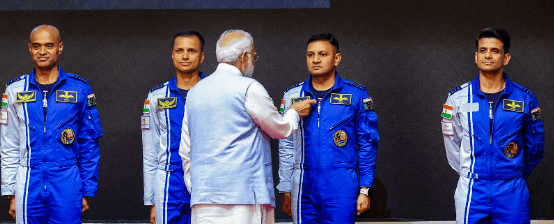
Indian Astronauts for Axiom-4 and the State of ISRO's Gaganyaan Program
Indian Astronauts Picked for Axiom-4 Mission
- The Indian Space Research Organisation (ISRO) has chosen two astronauts from those trained for the Gaganyaan mission to participate in the Axiom-4 mission.
- These astronauts will be sent to the International Space Station (ISS), in collaboration with NASA, based in the United States.

The Axiom-4 Mission
- Axiom-4 mission is a collaborative project between NASA and Axiom Space, a privately funded space infrastructure developer from America.
- The mission, which is the fourth one by private astronauts, aims to launch in August 2024 from the Kennedy Space Center in Florida.
- Aspirations for the mission include docking with the ISS for a span of fourteen days.
- Indian astronauts will be trained by NASA, alongside international partners and SpaceX, focussing on spacecraft systems and emergency readiness.
Status of India's Gaganyaan Program
- The Gaganyaan human spaceflight is projected to fly post-2025.
- The launch of manned flights will only occur following two successful unmanned missions.
About the International Space Station (IS)
- The ISS is a continuously crewed laboratory orbiting Earth, 400 kilometres above the surface.
- It hosts astronauts and cosmonauts and serves as a unique science lab with research in various fields such as medicine, technology, and science.
- The ISS is a collaborative effort involving 15 countries and five space agencies including NASA, Roscosmos, ESA, JAXA, and CSA.
- The ISS crew orbits the Earth every 90 minutes at a speed of 7.66 km/sec. Hence, in 24 hours, it orbits the Earth 16 times, witnessing 16 sunrises and sunsets.
- American astronaut, Peggy Whitson, holds the US record for spending the most total time in space, totaling 665 days.
- The ISS began its journey in 1998, with parts sent and assembled in orbit. It has been continuously crewed since the year 2000.
Upcoming ISRO Initiatives
- India is preparing to establish the country's first-ever space station by 2035.
- ISRO has plans to construct a 20-ton space station to support microgravity experiments within the coming decade.



Comments
Nam cursus tellus quis magna porta adipiscing. Donec et eros leo, non pellentesque arcu. Curabitur vitae mi enim, at vestibulum magna. Cum sociis natoque penatibus et magnis dis parturient montes, nascetur ridiculus mus. Sed sit amet sem a urna rutrumeger fringilla. Nam vel enim ipsum, et congue ante.
Cursus tellus quis magna porta adipiscin
View All